
The emergence of Week Without Driving on a national scale is one of the most promising developments in low-car/no-car activism in years. Launched for the first time in 2021 by Washington-based disability rights and transportation advocate Anna Zivarts, the annual observance is an excellent excuse for politicians, policymakers, or just regular folks to drive less.
As our planet and our local election heats up, and transportation emerges as a campaign issue, there was no question some Portland candidates would give it a try last week (the official dates of the challenge were September 30 to October 6th). And if it wasn’t on their radar, The Street Trust Action Fund put it there by asking them to participate as part of their endorsement process.
I’m aware of nine city council candidates who participated. Eight of those replied to my queries about it and seven sent me their responses in time for this post. I asked each candidate the same three questions (plus an open-ended one): 1) Why did you do it? 2) What two experiences would you like to share?, and 3) Did it change how you see transportation in Portland?
Below are reflections about Week Without Driving from seven Portland city council candidates…
Timur Ender, District 1 (East)
I participated in Week Without Driving because how we view our streets shapes public policy. I think this campaign presents an opportunity for people to have different experiences and to see their neighborhood from a different perspective. It also pushes people to plan and execute on what their multimodal choices would be if they needed to use them.
One memorable experience I had occurred on Wednesday, October 2nd. My day started at 6:30 am taking our foster child to school and ended at 10:30 pm biking back from a soccer game. As I was biking in between different events, I heard my oldest child playing at their friend’s house before school. I wasn’t aware they were going to be there. I biked over to her, wished them a great day, and gave her a hug and a kiss. It was the only time we saw each other that day. In the middle of a hectic day within the midst of a 15-month long city council campaign where I’ve sacrificed hours away from my kids and family, that moment meant a lot. Had I been in a car, I’m fairly sure I wouldn’t have heard them playing— nor would I have been driving on that local street in the first place.
I don’t think it changed how I view transportation issues as we frequently use transit, biking, and walking as a family but I did appreciate the opportunity to participate. (Learn more about Ender here.)
Marnie Glickman, District 2 (N/NE)
I decided to participate because I want to learn firsthand what it is like for one-third of Portlanders who do not drive or cannot afford to drive a car.
It was harder than I thought it would be. As a person living with multiple sclerosis, there were two days when I felt too weak to ride even my electric trike. I also discovered that it was easier for me to stay home (even during the final stretch of my campaign) than venture out into the city. Carrying my lawn signs onto the line 24 bus was too challenging for me.
The experience changed how I see transportation because I discovered how much more difficult and time-consuming transit was without a car and the ability to cycle in Portland. I can imagine a little more easily what life is like for so many Portlanders who are struggling to get from one place to another safely.
Portland’s transportation system should facilitate the safe movement of humans of all shapes, sizes, and abilities. Our transportation system needs to connect people together and build resilient, thriving communities without harming the environment and wildlife. (Learn more about Glickman here.)
Nat West, District 2 (N/NE)
For most weeks in a given year, I don’t drive. So this wasn’t so much a challenge for me as an opportunity to highlight alternative modes of transportation and participate in a bigger conversation. I really like the timing of this week as the seasons are changing. There are a lot of people who use more active modes when the weather is nicer but retreat to their cars when the rains come. So this week was hopefully an opportunity for people to experience a few chilly mornings on their commutes. As a daily cyclist, I really enjoyed seeing so many other people getting around via other modes like transit and walking.
On Friday morning, I got hit from someone running a stop sign on SE 7th. That’s the second time I was hit on that stretch of road this year. There is clearly work to be done, not just there but in many places of Portland. I also want to share that I went to a conference on Friday with a few hundred attendees and only saw two bikes there. So despite the publicity of the week, I don’t think the message got around to a lot of people.
I’ve been campaigning on transportation policy, and specifically safe streets for the last eight months, so I can’t say this week changed my perspective. But I’ll take every opportunity to talk to voters about larger bigger community efforts to engage more actively with transportation. It’s easy to ignore a single person riding a bike every day, but harder when you see many people talking about not driving.
I noticed quite a few other City Council candidates participating in Week Without Driving using various modes, but I didn’t see any mayoral candidates talking about it. Considering the bad driving records of Carmen Rubio and Rene Gonzalez, this dichotomy may be a sign of differences in vision in the new government come January. We may end up with some elected officials who clearly think the rules of the road don’t apply to them, and others who feel the impact of those bad behaviors. (Learn more about West here.)
Jesse Cornett, District 3 (SE)
I rarely drive any longer. For health and for lowered expenses, I enjoy my pedal-powered alternatives. This past week I was vexed by flats, which lead to unanticipated car trips. I finally got new tires and rim tape yesterday, so I hope the deflating trend is over!
I would estimate that 95% of my trips since June have been by bike, including to Council Crest (for fun) and Edgefield (for music!).
I feel as if I see the strides that have been made in the past decade for bicycle safety and better understand our transportation system because of my shift back to two wheels.
I’ve had one minor crash and surprised how easily I’ve been able to make minor repairs on. (Learn more about Cornett here.)
Rex Burkholder, District 3 (SE)
It was great to have an excuse to break out the trailer and do some serious shopping without a car.
I try to make every week a week without driving, but sometimes, when the rain is pouring or I have many destinations to get to and I’m tired, having a goal of not driving — for all the very good reasons not to drive a car — gets me over the hump and back on my bike.
First, I got a lot more mileage in on my bike, with having to canvass voters in a large geographic area as well as attending voters forums, I was going from one end of town to the other more than usual.
Second, is that I did drive a car one day to take my partner, Lydia, to Kaiser to get a cast on her broken wrist. She has not been able to ride a bike (and is very frustrated) after breaking her wrist when she tripped hiking. She also has difficulty driving so I was her willing driver that day. Transit would have been an hour trip with two transfers to get to Kaiser, a taxi trip, or a 10 minute drive. We make choices.
As a regular bicycle user and walker, my experiences weren’t that much different.
I think that we should require all City of Portland employees, at least those working in transportation, and our future councilors and mayor as well, to experience a week without driving to understand what many Portlanders experience everyday — those who have no choice but to walk, take transit, or cycle due to income, age, disability or other situation that makes driving a car impossible. (Learn more about Burkholder here.)
Chad Lykins, District 4 (West/Sellwood)
I did the week without driving both because I’m a big supporter of active transportation and because I wanted to show solidarity with those for whom driving is not an option. To make it work, I had to rig my bike up for more carrying capacity for delivering yard signs. I was able to do some tasks on a bike that had previously been more challenging. Also, I finally got to ride my bike to a Timbers game at Providence Park. The bike parking there is amazing!
I already knew a lot of the challenges and joys to be found on Portland roads, partly from the ride-along Jonathan and I did together.
I would point out that the Week Without Driving isn’t just about bikes. I thought a lot about people who have various disabilities that prevent them from walking, riding, or driving. Our city needs to be a place where all people are able to get around. (Learn more about Lykins here.)
Mitch Green, District 4 (West/Sellwood)
Driving less is important to me, and I realize I’m still car-dependent for accomplishing certain things during the week out of convenience or necessity. A Week Without Driving felt like any other week because I’ve always challenged myself to use other ways of getting around like the bus or biking even when I’m privileged to own a car. I put in extra effort to bike everywhere first, then took transit when biking for the entire day wasn’t feasible. I still rode 6 out of 7 days, with the exception of Thursday when I had multiple interviews nearly back-to-back.
What I didn’t expect when I took the pledge was experiencing a health issue that made walking painful for a few days and required bedrest per doctor’s orders. I thought I could still bike easily when the pain subsided, but it wasn’t. My campaign manager also got her bike stolen the previous week, and these events amplified just how much more planning, coordination, and effort it took to get around when we depend on biking and walking as our primary modes of transportation. Campaigning involves traveling to several locations throughout the day back-to-back, while transporting ourselves and materials.
A Week Without Driving amplified a lot ot the experiences my southwest Portland neighbors have told me when talking to them at doors –hundreds of them – over the past few weeks. In West Portland Park, Hayhurst and Maplewood, walking to school or a bus stop can be long and treacherous with hills and without sidewalks. Trip-chaining or going from one location to another, especially for families with young children or family members with disabilities, can be much easier with a car. For people who are bike and transit-dependent, they have to negotiate schedules, consequences for lateness, decisions about safety and comfort, and costs in a way that aren’t as relevant to people who can easily drive around. (Learn more about Green here.)


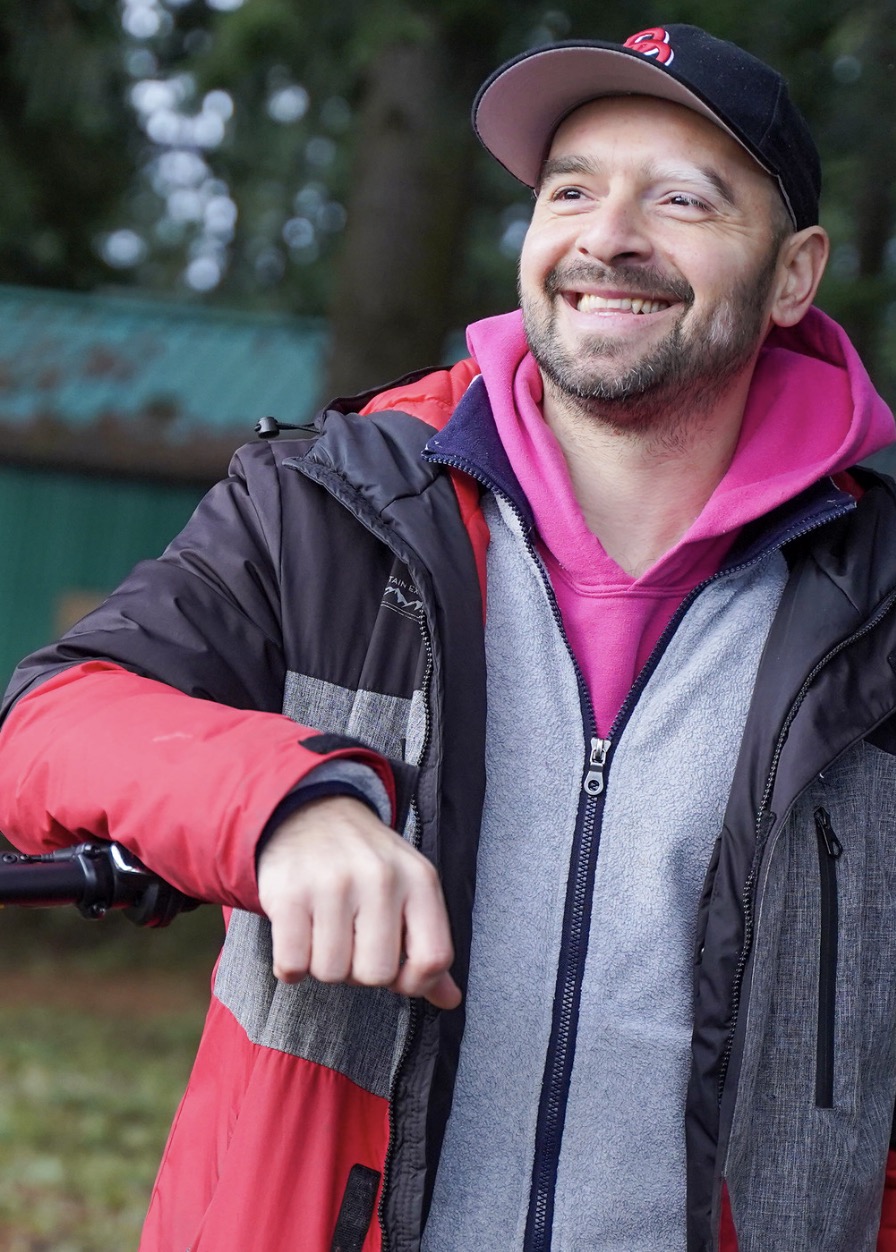
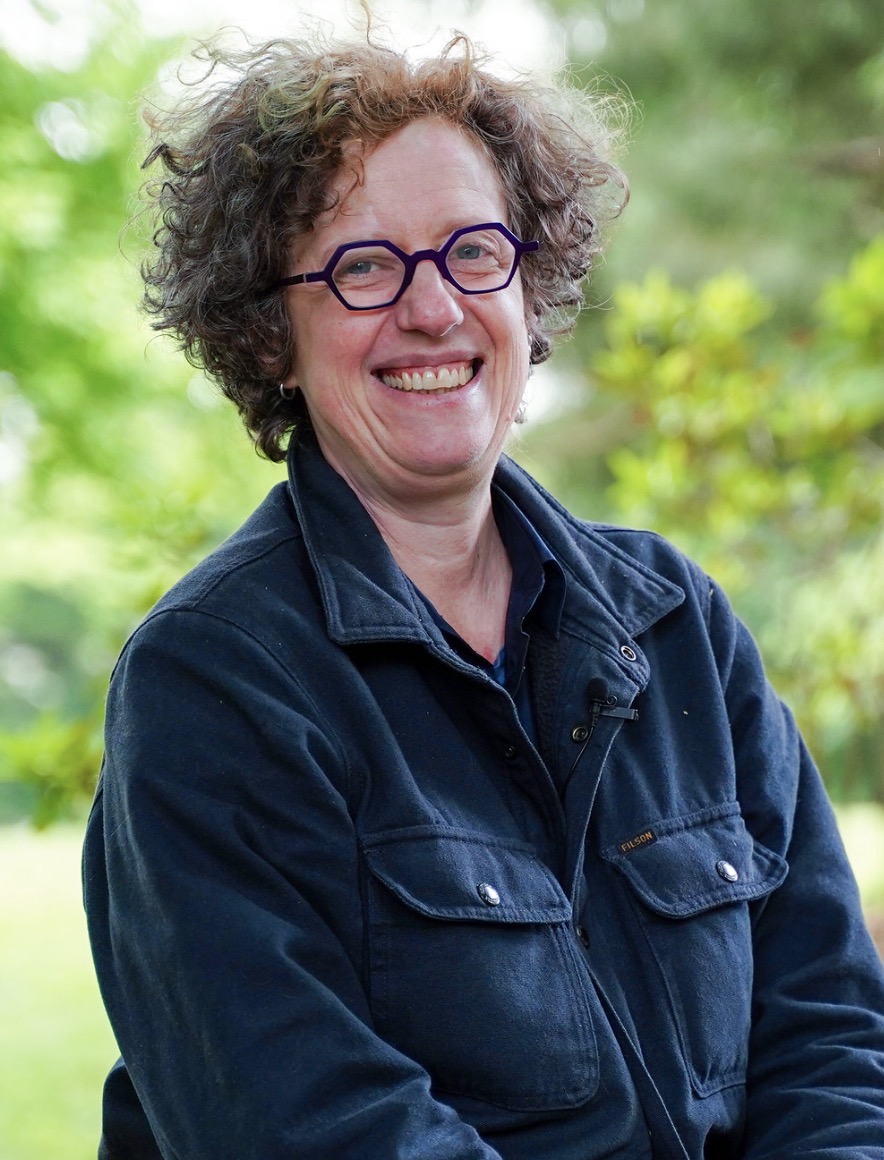

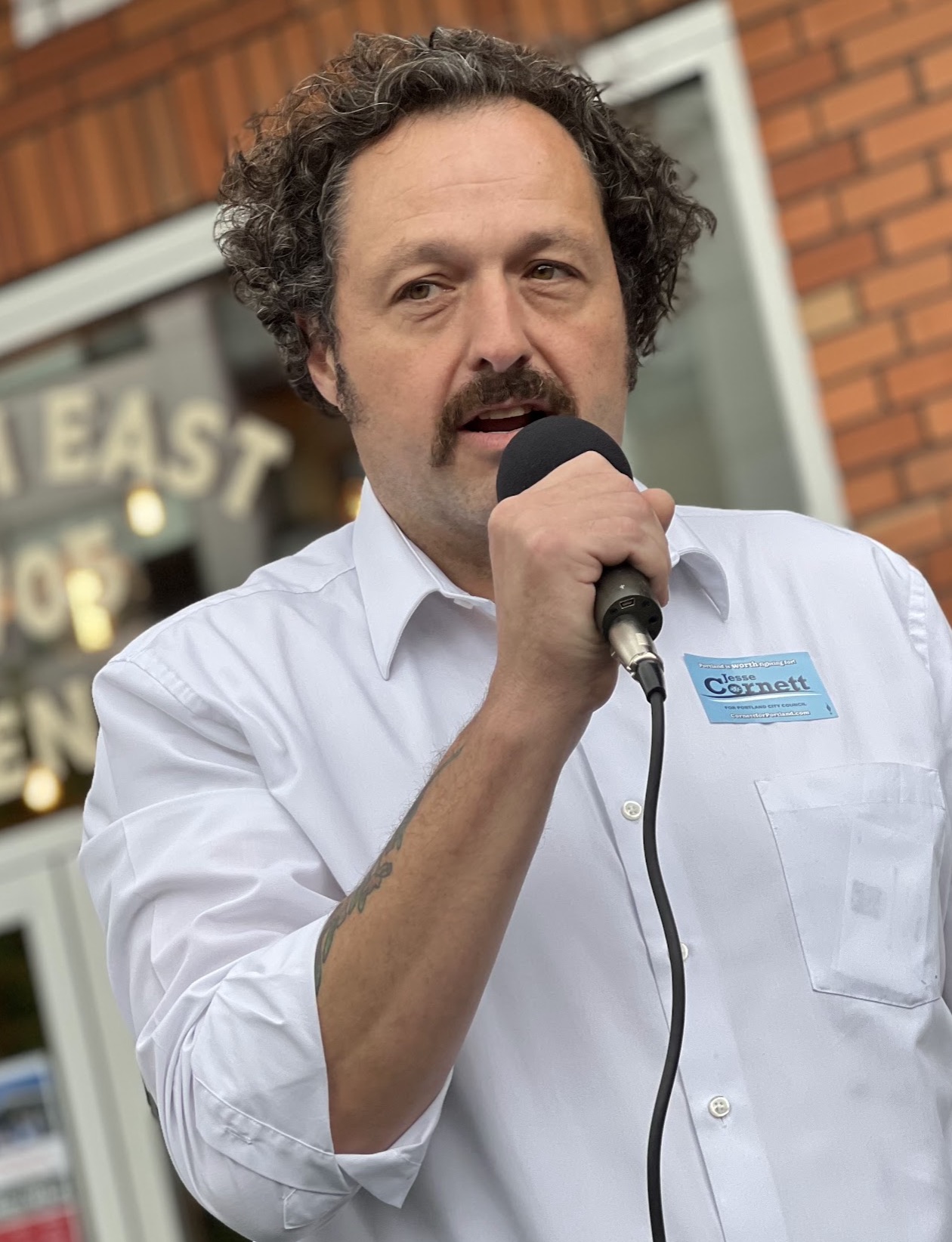
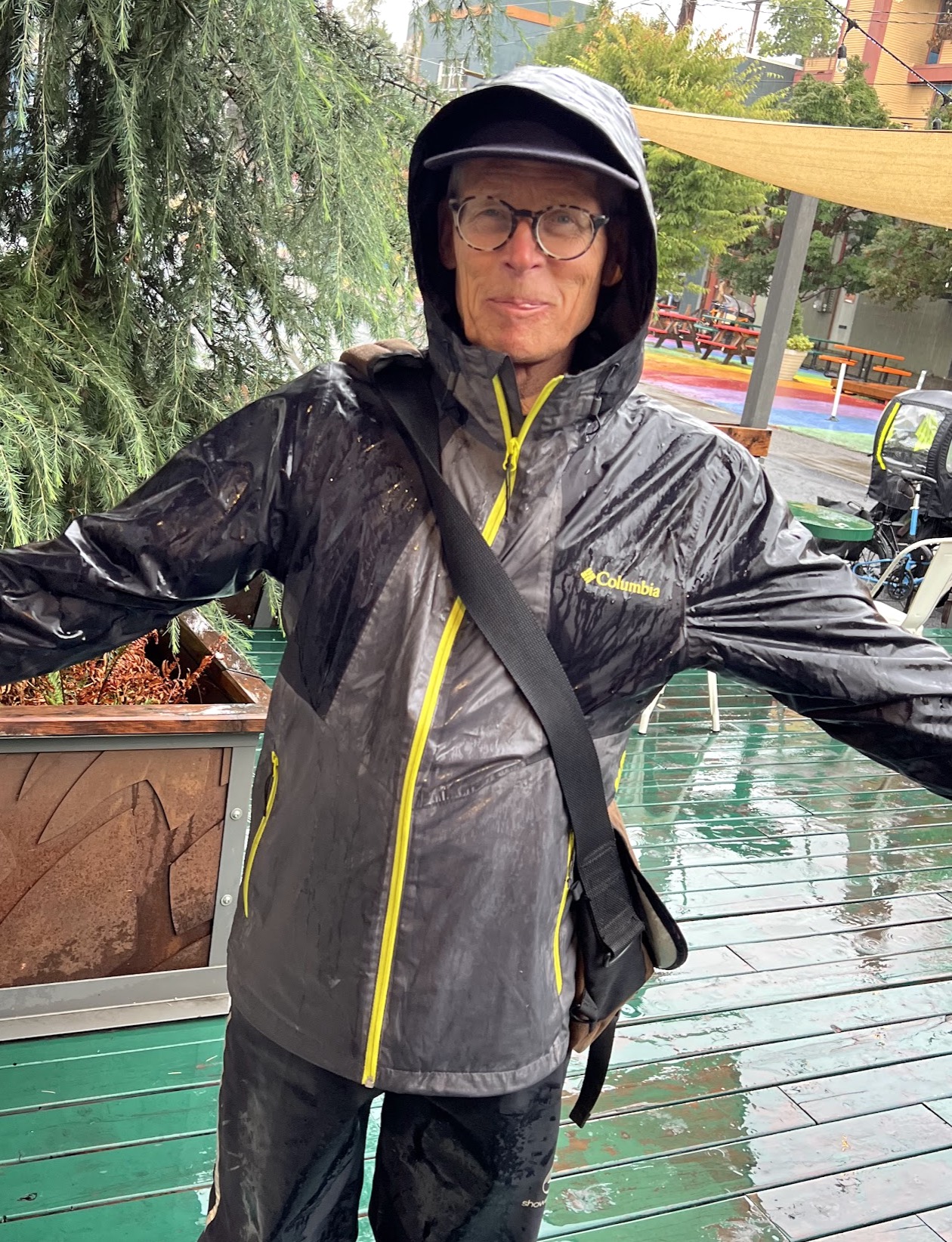

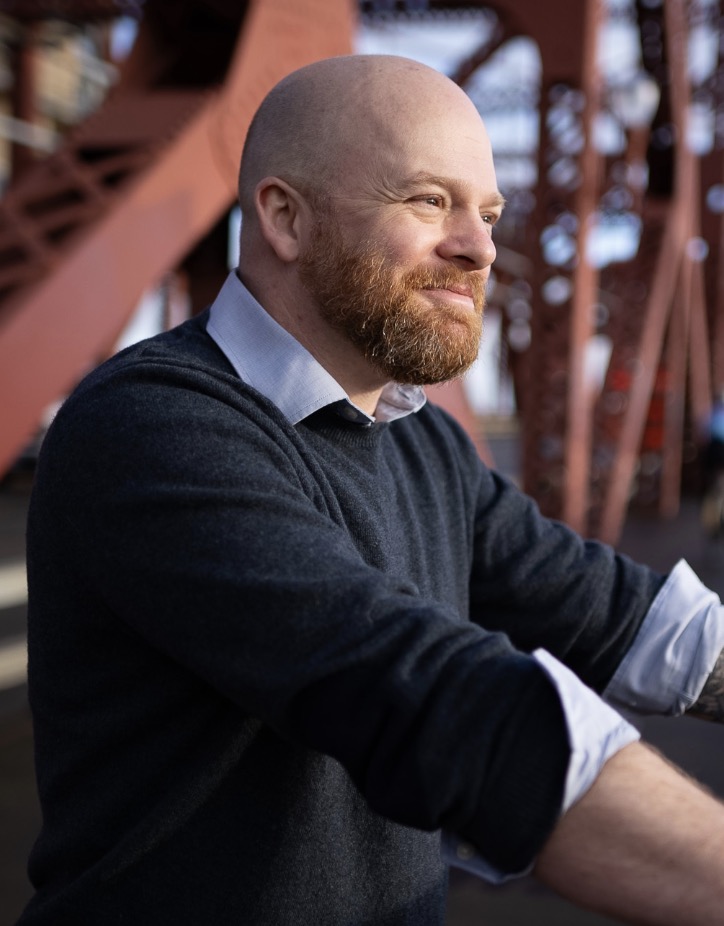
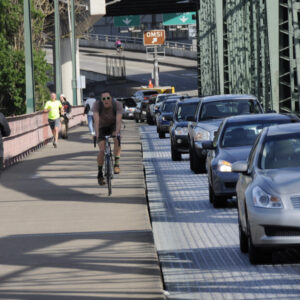
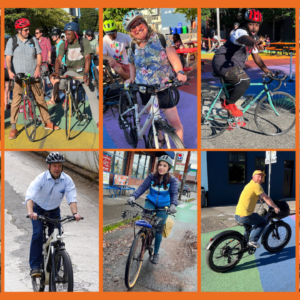
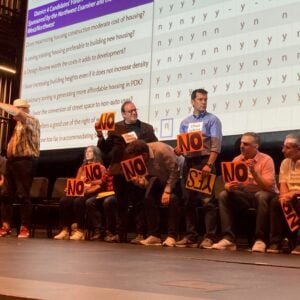

Thanks for reading.
BikePortland has served this community with independent community journalism since 2005. We rely on subscriptions from readers like you to survive. Your financial support is vital in keeping this valuable resource alive and well.
Please subscribe today to strengthen and expand our work.
I’m really glad to see candidates trying this out. I am 100% car-free my whole adult life, and I feel that it’s such an important perspective especially for those whose 95% of their trips are already car-free. Because that last 5% are the hardest trips that I have to make do without a car; like, these occasions the candidates have encountered:
> As a person living with multiple sclerosis, there were two days when I felt too weak to ride even my electric trike. I also discovered that it was easier for me to stay home (even during the final stretch of my campaign) than venture out into the city. Carrying my lawn signs onto the line 24 bus was too challenging for me.
> Second, is that I did drive a car one day to take my partner, Lydia, to Kaiser to get a cast on her broken wrist. She has not been able to ride a bike (and is very frustrated) after breaking her wrist when she tripped hiking. She also has difficulty driving so I was her willing driver that day. Transit would have been an hour trip with two transfers to get to Kaiser, a taxi trip, or a 10 minute drive. We make choices.
> What I didn’t expect when I took the pledge was experiencing a health issue that made walking painful for a few days and required bedrest per doctor’s orders. I thought I could still bike easily when the pain subsided, but it wasn’t.
I’m really liking Nat West. Glad he participated
This week too 🙂
gotta move to your district before the election, writing in the BikePortland comment’s section is the only way to guarantee I’ll vote for someone (only half kidding)
Dist 2 is lucky to have him
I love being car-free when I live in a city which supports it. In the past, I’ve lived that way for a decade and a half.
But where I live on the west side (Portland Heights, which ain’t exactly in the middle of nowhere) the bus doesn’t run frequently enough for anybody but high school students commuting to Lincoln to use it (and then, only for regular school hours–no weekends or nights). Without a bus to get downtown, I’m cut-off from the rest of the transit system.
Heading downtown, my last 51 is at 8:00 AM, and it starts running again at ten till four. That’s an 8 hour service gap.
But, as Mitch Green touched upon, many southwest Portlanders can’t even reach a bus stop because there is no safe place to walk. In most neighborhoods, pedestrians share the asphalt with speeding cars. For example, on Shattuck Road.
Everyone has their own reasons for choosing an area to live, and life has a way of throwing wrenches in to things, but bikeablitty was a top factor for myself.
Personally I wanted to live car free and be able to bike everywhere so I decided on a bikeable neighborhood close in here in Portland even though that meant I would get less space, more people per square mile around me, and pay more per square foot.
But what gets me are the able bodied people that live close in and could easily ride or take transit but make a choice not to – how do we reach them?
I’m not sure they are reachable.
Biking requires effort and exposure to the elements. I love riding for short to medium length trips, as does most of my peer group, but plenty of people just don’t like it.
And transit? Anyone who places a higher value on travel time, flexibility, cost, and convenience over something abstract like “the communal good” will likely choose not to use transit unless they have to, except for some specific trips.
Transit just isn’t very good in the general case.
And also, there’s this:
https://www.oregonlive.com/commuting/2024/10/roughly-half-of-trimet-riders-feel-unsafe-82-say-other-riders-behavior-is-the-reason-why.html
Every time our city interviews any of the top 5 bus contractors to supply workers and manage our local bus service, they always tell us that the quickest way to increase ridership AND bus security is to remove all car parking on arterial stroads AND add bus-only lanes AND give bus drivers the same signal priorities as the fire department. By doing so, the city makes car driving significantly less fun and convenient, and transit gets somewhat more competitive in terms of time. Each of these 5 contractors are foreign (2 British and 3 French) who run bus systems all over the world, including many major US cities (but not TriMet) and they have extensive experience about what works and what doesn’t – it’s not rocket science – when your local population beyond the driverless 30% of “captured riders” have a lousy choice between traffic gridlock and taking “fast” transit with wifi (which is standard now), those new “choice” riders tend to figure out ways to get rid of your problem riders on their own, and the system largely fixes itself.
One weird trick to fix transit, and it sounds so easy. Why don’t you guys just do that?
We’ve been told repeatedly by all 5 companies to do so, yet we’ve never done it for the same reasons that Portland doesn’t do it – car culture, politics, defeatism, call it what you like – and so our local service use languishes.
I have to hard disagree on transit in general not being good or compelling.
Cities like London or Tokyo have fantastic transit experiences, including not just frequency, reliability, and coverage of the trains themselves – but also the wraparound experience of shopping, dining, etc in and around each station. Things are dense and convenient in a way they simply can’t be in a car-dominated city. If you want to live somewhere like that, you’re more likely than not entering a situation where using a car to get around makes little practical sense for most people.
And that’s before you even get into the tradeoff of having to deal with:
All of which added up quickly become competitive with a second rent payment.
It’s simply not true that “caring about the greater good” is the only reason someone might prefer transit over driving. Owning a car is heinously expensive, and that’s with *massive* public subsidies that obfuscate the true cost we’re all paying for car infrastructure.
It might seem like a no-brainer to have an expensive private vehicle if you’ve got cash to burn, but an ever-increasing number of people are skating on thin ice with car-related expenses only because they feel they have no viable alternative (not to mention many people who’ve already hit the point of losing car access entirely for cost reasons). The answer, in a lot of cases, to “how do we reach them?” is to make sure people feel like they do in fact have a choice that doesn’t require them to blow up to 40% of their take-home pay on transportation. And a big part of that is just making transit service a better experience, more frequent, and more reliable.
There is an excellent City Nerd video that starts with an old quote asserting that Americans spending about a quarter of their waking life in a car or at a job working to pay for a car. He crunches some numbers and breaks it down by city, of course with numbers updated for today. And the quote was not far off.
Some of the worst places are in California, where it’s over a 25% of your waking life dedicated to your car. The very best place was Cambridge, MA where it was still 7.4% of your waking life. Places like NYC were of course pretty good.
I think people just don’t realize how much of their time is spent dealing with their car, and if they did, other options might look better. Plus, we could actually make the other options suck less by actually funding them. So far, we’ve tried bad public transit and surprise, people don’t like it!
I fully agree. Both of these cities have excellent transit, befitting their status as world capitals*. And yes, those cities benefit from a completely different physical configuration than we do, with many services close to where people live (in the center parts, at least; this is less true further from the core).
It is also true that the total cost of car ownership can be high, but buying an older car can significantly reduce it. I have owned a car for much of my adult life, and I have never had costs that even come remotely close to a rent payment. It’s a choice to pay that much.
But if you have a car for other reasons, because you like to go hiking, for example, or visit other places, or be able to buy lumber at Mr. Plywood, then most of those costs are sunk. The marginal cost of making any particular trip can be quite low, certainly less than bus fare for trips around the city.
I think most residents of areas with good (for Portland) transit coverage understand they could get rid of their car, and some do. But I think that many people believe doing so would overly constrain their lives in various ways, and find that the cost of car ownership is simply worth it.
Actually, we know this is true because so many people choose to buy a car, including me (along with many others on these forums who decry cars in general). I find it’s worth having one even if I drive it fewer than ten times per year. For me, and many others, owning a car is a rational choice even if in principle unnecessary.
I agree that would help, but I think the potential of our current model is limited.
*I think this is true; it’s hard to really know about coverage and such until you’ve lived in a place a while. Most visitors to Portland (and even many Portlanders from other parts of the city) would overlook the massive service gaps in SW, for example. I didn’t realize how bad it was until Lisa started writing about it, and I generally pay attention to stuff like that.
I think you’re right about people in Portland being truly multi-modal in how they get around, including with their car occasionally.
Your comment reminded me of a professor I had in college who was a dedicated all-weather bicyclist (in Missoula, MT!), except for the one or two days per year that she had to take her cat to the vet. Apparently she attempted to carry the cat on her bike once and it was a disaster, so she kept an old beater. As I know well, people do mysterious things for their pets.
Lol! My cat is the exact opposite. She HATES being in the car. Like, screams the whole time and absolutely loathes me for hours after a ride in the car. I take her to the vet by strapping her carrier to my bike rack and she loves it! She is normally an indoor cat so I think she likes the sights, smells, and sounds of the outdoors going past at a speed she can process. Not unlike the reasons my mammal brain likes riding a bike I suppose.
Us too, and we chose this neighborhood because it was on the right side of the river for my husband’s work, and he has been able to bike to work for most of the nearly 25 years we’ve been here.
But speaking of wrenches, when we moved here the bus ran 6 days a week, into the evening. We were in our 40s and had lived in enough places that we knew how to pick a neighborhood (grocery store across the street, bus stop around the corner, bikeable to work, good schools). We are savvy neighborhood pickers, and it has never had anything to do with maximizing square footage, far from it. But Portland changed under our feet. Repeated bus cuts, grocery store closed.
The lack of bus service impacts me, not him. Impacts me and every child who doesn’t drive, all the older people, the disabled guy across the street. And I think it probably has partly screwed up downtown Portland too. It isn’t a good urban planning to make it difficult for the innermost neighborhood to reach the city center, but that sure looks like the 25 years of policy I’ve watched.
Re your last paragraph, that’s the humdinger. I love the bus, but a lot of Portlanders seem to think it is déclassé.
Lisa, you live along/rely on Line 51, right? Without that line, it’s a looooong way to the next-nearest line. It’s a perfect example of the vicious circle of transit frequency reductions. People can’t rely on it as much, so they ride it less, more service cuts come along, repeat. Public transit is called “investment” for a reason.
Thanks for replying Nat, I think we talked about the 51 once at a bike happy hour last year. You are correct about the investment part, I remember (20 years ago) that bus being full with downtown commuters. But the line has been ground down through repeated service cuts. Another popular line which was cut was the #1 on Vermont.
That said, I think Jarret Walker’s redesign was really good, given the assignment. But I think what he wasn’t tasked with understanding is that these lines had already experienced several significant cuts over the 20 years previous to covid, and then covid killed them off. (The 2008 cuts were supposed to be temporary, just a short-term thing because of the economy.)
Good luck with the campaign, a lot of people are rooting for you!
Don’t think I remembered the story of the previous cuts to the 51, that’s good to keep in mind. I guess I drove it as a shadow of its former self- just a school bus, really.
Even if Trimet ran ten minute service all day long on that line, ridership wouldn’t only tick up a bit. It’s a demographic issue in that area.
Bus service is use it or lose it. The residents of Portland Heights chose to lose it.
Just come out and say it, you hate Portland Heights. But it is true that many people who live here now wouldn’t use it. How does that happen? Here’s my theory.
We chose this neighborhood 23 years ago because it was close to downtown and had bus service. The bus service was a big part of the decision. The people who have moved here since 2008 don’t give a damn about bus service or they wouldn’t have moved to this neighborhood.
So, over time, a neighborhood evolves to match service levels, and it is work and time to grow ridership back.
I have no beef with Portland Heights. I grew up very near there. It wouldn’t be my first choice in neighborhoods due to the isolation and lack of sidewalks, but our jobs are on the east side, so Laurelhurst was an easy choice.
FWIW, I’ve observed the same issues in our neighborhood. Families in our neighborhood could easily walk or take the bus but it seems like we are the only ones who do it regularly. I don’t know if it’s perceived safety issues or just the small amount of added time, but it seems that the “choice” riders have completely fled Trimet since the pandemic.
Bus service in Laurelhurst (where you mentioned you live below) exists in spite of the residents of Laurelhurst. It cannot be cut because where else would the #20 go? Sure, the #19 on the historic Montavilla route has seen cuts, but that’s also in the context of the MAX being built and prioritized. Plus, the #75 can’t exactly not serve Laurelhurst on Cesar Chavez.
Sure, bus service is “use it or lose it” in some sense, but isolating some neighborhoods as “not using the bus, so they don’t deserve it” is not useful or even true. The #8 gets frequent service into Irvington and serves potentially the most important employment center in the city (OHSU), but doesn’t actually get a ton of ridership north of Broadway and it’s the least busy frequent service line by rides per revenue hour (at 6.0). Does Irvington “not deserve” quality bus service?
The geography of the city plays a huge role in who gets bus service, which probably explains cuts to the 51 far more than neighborhood level ridership. But Portland Heights has continually lost out at least in part because of a lack of prioritization on service to parks. After all, the 51 is the descendant of the Council Crest line, and quality transit service to parks is rarely a priority – just look at the state of riding transit to Forest Park.
Nat, you and Lisa bring up a very good point. I studied transportation in Copenhagen last year and in a meeting with the bus company, they mentioned that they maintained service/frequency throughout the pandemic because they understood that while buses may be empty for a time and they’d lose money short-term, if they cut anything they’d kick of the very feedback loop of disinvestment that you mentioned. By last year (June 2023) they were almost back to pre-pandemic ridership numbers, while TriMet is still stalled at less than half what it was, if I have my numbers right.
https://www.axios.com/local/portland/2023/12/15/trimet-ridership-public-transit-fares-increase-price-cost
Of important note is that ridership at TriMet has rebounded somewhat from the bottom in 2020, but it’s also shifted. Lines that used to take commuters downtown are donezo.
I like where you’re going with this Mel. If you build it, they will come. And due to how transportation is financed in Oregon, more transit funding must come with decreased funding for other modes.
Déclassé or does it feel unsafe?
Do you all know how much work it took me to get those accents on? And you all just get to cut and paste.
I’m saying déclassé, at least with w my anecdotal conversations, which are happening in a well-off neighborhood served by a safe, clean bus. You have to bring the subject up the right way, or you get “preference falsification.”
It gets expressed as a spontaneous, “I’m not going to take the bus,” and it’s the way “bus” is said that is revealing. If you probe further and give them time, they may serve up the other reasons, but it’s that first, emotional, “bus” that tells you what they are feeling.
In big cities, with good service, bus usage trends older because younger people can walk really fast for long distances. But I’ve always, even when I was young, liked the bus. I get the feeling that a lot of people in Portland who don’t take public transit have never done it before.
I can understand the “déclassé” concept quite well. In my NC community both our local service and our regional intercity service are public systems, as are the bus services in adjacent cities and most other places, DC for example – only Greyhound and a couple other similar long-distance services are private – and all the public bus services have proven to be very safe and secure, but not as frequent as one would like and many places have no service at all, even some medium-density urban areas. The vast majority of users here are visible minorities – African Americans, Latinx, immigrants and refugees, and disabled of all races – whereas most “healthy white wholesome American” people seem to avoid using the bus if at all possible (even my use is rare, maybe 6 times per year). Although homeless residents sometimes use the bus (or are allowed to board by the mostly black and Latinx contract drivers), most users are people getting to work, to school, or to appointments. Many “minority” passengers report on local surveys that they like their bus service, as bad as it is, because they feel a bond with the drivers and it’s one of the few transport modes where the police cannot harass them (many local blacks report being pulled over by police when they pass through the “wrong” parts of town, when driving, walking, jogging, and bicycling – which most community governments readily acknowledge.)
Comment of the week? Conflict of interest I guess 🙂
This is an interesting perspective. You used to bus more but funding cuts and other things made it worse. I used to live in SW, right near Tigard, but I was lucky to be on the #12 line. It was fairly fast getting downtown, but that was probably the best case bus line.
When some people say transit just isn’t good, that’s really a generalization. Comparing bad public transit to best case scenarios for cars is kind of ridiculous. The best way to get around is whatever we as a society decide to prioritize.
It absolutely is. I try to fully acknowledge that for some trips, transit is a great choice, perhaps even the best one. I try to make clear that I think it fails to satisfy in the general case, not every specific one.
If you are on a frequent transit line, and are traveling to somewhere else on that line, and it doesn’t involve crossing downtown, transit is probably your best choice, even in today’s Portland.
For me, bike is the absolutely best way to get around. Car is a distant second or third for most trips. The best way to get around is whatever works best for you in your situation.
Just spitballing, but maybe a core message other than “cars suck” when we’re trying to reach car drivers might be a start? We need to quit telling people why they should ride, and quit judging people who don’t.
Based on the complaints I see on this blog, I wonder what percentage would still ride if they were in the circumstances most people are in?
Why people ride or don’t ride is a personal choice. I’ve ridden my whole life, put in more than 20 utility miles today (close to 80 since Monday), have hundreds of thousands of total miles, ride for fun, blah blah blah, and none of those miles are related to reducing cars, reducing carbon impact, and much of the stuff posted here.
If you want car drivers to start cycling, the message needs to be based on the fact that car culture is real. Every place I’ve ever lived except Portland, I’ve gotten others cycling — we’re talking big truck guys. But cycling is a “thing” here, which really turns a lot of people off. Despite being a lifelong cyclist, I doubt I’d be one if I grew up here. We need to quit demonizing the target audience, skip the proselytizing, and just make the better path self evident.
Also be real about what’s out there. I just rode back from SE to NoPo. Google tried to guide me through desolate/creepy places that are supposedly bike friendly. I’ve had trouble in some of these places in the past — I strongly prefer riding with the cars because they’re easier to understand even with drunken fools at the wheel and took Sandy and MLK for a good chunk back.
If you’re wondering why abled bodied people would sit in a parking lot when they could easily cycle much faster for a short commute, it’s because they enjoy the environment inside their cars — just ask around.
The first step to improving transit access to that neighborhood is changing the zoning and allowing the neighborhood to thicken up. R5 and R10 aren’t conducive to transit ridership.
Help me with the zoning, somebody. It’s what I know least about. Didn’t Portland get rid of zoning a few years back? Residential infill, missing middle and ADUs are the marching orders.
I’m about a stone’s throw from about four infill lot divisions, so we are pretty thickened from where I sit. You can’t fit more dwellings in without tearing some down first, and the structures are worth too much to do that.
I’m reading Charles Marohn’s most recent book, Escaping the Housing Trap. If you want more housing up here, the city needs to tax empty structures, and double the tax every year. Then you could build high density on the Strohecker grocery store property instead of letting it sit empty for, what, a decade?
Portland still very much has zoning. The rules changed a few years ago, but there are still plenty of rules.
You can see it all here:
https://www.portlandmaps.com/bps/zoning/#/map/
Find the zone and overlays, then look what each allows. It’s plenty complicated, but you’re plenty smart.
I just took a quick look at the zoning map and now I remember that anything with a “z” after it is labeled “constrained.”
You’d need to change the zoning from R5-10 to RM2-4 to make it work, but it would work. The (z) sites probably won’t have their zoning changed because those tend to be on fairly steep slopes, but those large R10, R5, and R7 blocks along Vista could and should be.
I attended a conference On Sept 23rd in which Anna Zivarts was one of the main speakers. She was openly not pleased when the organizers of the annual NC BikeWalk Transportation Summit scheduled all events, including the conference venue, the bike and walk audits, and the evening get togethers, only at locations that were accessible by car, in the college town of Chapel Hill (UNC), and that the vast majority of attendees did in fact come by car (I was one of the few who didn’t have a car – I came by train, then biked, and returned home by regional bus.) She’s a very good speaker, I highly recommend attending a talk with her if you get an opportunity. At one point she asked our audience of about 250 advocates, planners, and students, mostly from NC and predominantly from the Durham/Chapel Hill/Raleigh area, who couldn’t drive – I was one of three people in the auditorium other than Anna who couldn’t drive, the other two were both young male students.
Curious what route and tips Cornett has for reaching Edgefield by bike. There appears to be walkable (bikeable?) routes via Birch, Elm, Donald L. Roberston City Park, and NE 244th Ave into Edgefield. The lack of a bike lane, sidewalk, or even a shoulder on outer SW Halsey St in Troutdale is a deterrent.
The bike lanes on Halsey are continuous all the way to Edgefield, but there are a few substandard sections between 181st and 201st. Coming from NE, I would always just go straight out Halsey. If you are coming from SE, the Springwater to the Gresham Fairview and then east on Halsey is a good route.
WalkScore(tm) has some interesting tools which i think get at the heart of this issue as it will show you all the places in town you can reach in a designated amount of time by car, transit, bike and foot.
Most people in my neighborhood (Lents Park) drive cause unless you’re going to the Hawthorne strip or FoPo (the wonderful #14) or Gateway (Max but why go there?), Hollywood (Max but why go there?), you’d have to be a bored single guy like me to use transit.
82nd on the bus IS declasse even for a declasse guy like me.
Biking with the MUPs and crazy drivers the way they are in East Po is a no for alot of people.
Thus with the addict situation being what it is I don’t think this conversation is very helpful at all, the addicts have completely changed this conversation.
Once this fentanyl thing dies down, which it will, (doctors are being quoted as saying it will die off for among other reasons, that those who are inclined to use in this fashion will soon either die or quit)…
Then we can talk about transit and biking modal share in Portland with a clearer view.
Portlanders in my experience are willing to ride bikes, take the bus and train, but not anymore. Its crazy out there!
I found myself dismayed by some of these responses, because I can easily imagine some of the legitimate challenges (carrying heavy loads, physical limitations) being used to reinforce the idea that we need to direct more–not less–investment in driving. If I weren’t already a massive transportation nerd, I could see myself reading this article and thinking “well, sometimes you just HAVE to drive.” After all, that’s what a lot (most?) of these candidates did when presented with these challenges.
I don’t fault anyone for choosing driving because they feel they’re out of options. But amazing things happen when we do have other options. I once went to pick my kids up from school and realized when I got there, 5.5 miles from home, that I had forgotten their helmets. My first thought was ugh, the only way around this is to call my husband and have him drive the helmets to me, or just drive the kids back. Only after reflecting for a minute did I realize I could park my bike at the OHSU bike garage and take the bus home. It worked out well, but only because both a nearby bike garage (for which I had access) and a relatively convenient bus route with decent frequency were at our disposal. Basically, we were in a position where the city and the institutions in our orbit had made options other than driving feasible and practical.
It can be done city-wide. I lived car-free in three different cities in Germany in the aughts, and occasionally I had some of these challenges (e.g., getting around after knee surgery, carrying heavy luggage home after a trip). I always found a way around them because all three cities had good ped, bike, bus and streetcar infrastructure, and two of them had great commuter/light rail (U-Bahn and S-Bahn) and great access to long-distance trains. For the rest, I took taxis. Other than the couple of times I rented a car (e.g., to move apartments), I went six-years without driving. It can be done, but only if we invest in it and go all-in.
I hope the takeaway for people (including these candidates as well as voters) is that we need more choice. More options. Layers of transportation and modal diversity, where when one option fails, another presents itself and we can get out of the mindset of “guess I just HAVE to drive.”
I also want to be clear that I don’t equate knee surgery with something like MS… clearly one is temporary and the other is permanent. And driving may still be the go-to when that’s the case, as is true for many Europeans as well. I have massive respect for Marnie Glickman, who I read has worked a trike into her life to get around balance issues on a bike after her MS diagnosis. Very understandable that in some cases, she would also need to drive. I hope my comment doesn’t come across as insensitive to that.